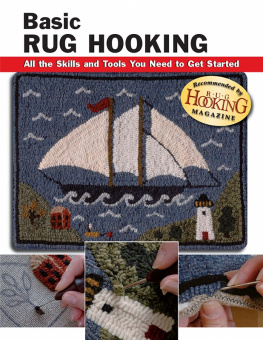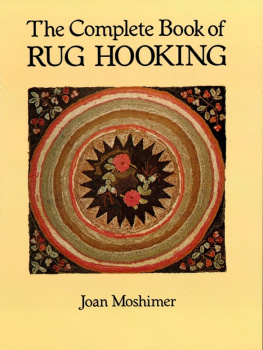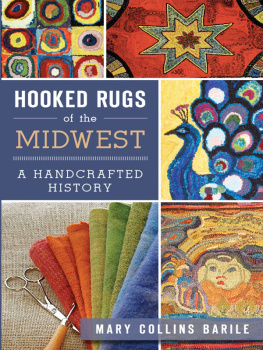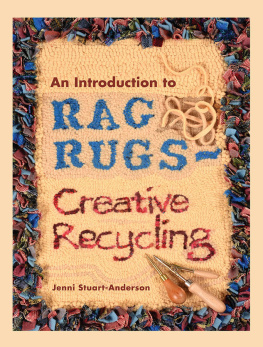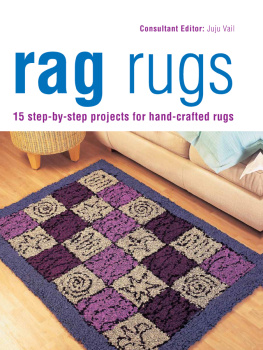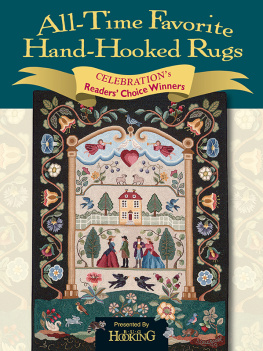Fretz - Hooking Rugs
Here you can read online Fretz - Hooking Rugs full text of the book (entire story) in english for free. Download pdf and epub, get meaning, cover and reviews about this ebook. City: Pownal;Vt, year: 1990, publisher: Storey Publishing, LLC;Garden Way Pub, genre: Home and family. Description of the work, (preface) as well as reviews are available. Best literature library LitArk.com created for fans of good reading and offers a wide selection of genres:
Romance novel
Science fiction
Adventure
Detective
Science
History
Home and family
Prose
Art
Politics
Computer
Non-fiction
Religion
Business
Children
Humor
Choose a favorite category and find really read worthwhile books. Enjoy immersion in the world of imagination, feel the emotions of the characters or learn something new for yourself, make an fascinating discovery.

- Book:Hooking Rugs
- Author:
- Publisher:Storey Publishing, LLC;Garden Way Pub
- Genre:
- Year:1990
- City:Pownal;Vt
- Rating:4 / 5
- Favourites:Add to favourites
- Your mark:
- 80
- 1
- 2
- 3
- 4
- 5
Hooking Rugs: summary, description and annotation
We offer to read an annotation, description, summary or preface (depends on what the author of the book "Hooking Rugs" wrote himself). If you haven't found the necessary information about the book — write in the comments, we will try to find it.
Hooking Rugs — read online for free the complete book (whole text) full work
Below is the text of the book, divided by pages. System saving the place of the last page read, allows you to conveniently read the book "Hooking Rugs" online for free, without having to search again every time where you left off. Put a bookmark, and you can go to the page where you finished reading at any time.
Font size:
Interval:
Bookmark:
Hooking Rugs

by Lila Fretz
Men, women, young and oldall can hook. The manual dexterity and keen eyesight required for some needlecrafts are unnecessary for rug hooking. Learning one easy stitch makes it possible to hook any design. There is no threading of a needle, no counting of fine threads, and no elaborate finishing procedures. Of all needlecrafts, rug hooking is one of the least expensive, easiest, and yet most creative. In the past even the hook was handmade from a nail and given a wooden handle. Be prepared to take some good-natured kidding when you tell your friends youre a hooker.
Possibly the earliest sample of hooking was done by the Vikings in the Bronze Age. It is on display in the Oslo Museum in Norway. Much later rug hooking using wool yarns surfaced in England, a country with an active textile industry. North American rug hooking with wool materials was first done in coastal areas, mainly New England, Nova Scotia, and Canada, where the craft was introduced by sailors and settlers from Europe. Slowly the craft spread to rural areas of the East and Midwest United States.
Textiles, being extremely time-consuming and later expensive to make, were never discarded. Heeding the old New England saying, Use it up, wear it out, make it do, do without, hooking provided a use for material too worn for any other purpose.
Rugs were also hooked for warmth. The first rugs, bed ruggs, were used on beds. Later most rugs were used on the dirt and board floors to ward off chills.
Finally, there was a longing for beauty in a household where only the essentials were considered important. The early housewife could draw her own design on linen with charcoal, use worn-out clothing as is, or overdye her wools with leaves, berries, and wildflowers for different colors, unwittingly creating a folk art that now helps to tell the story of our ancestors and their times.
Rug hooking became very popular during the middle to late 1800s. Traveling as a tin peddler near Biddeford, Maine, Civil War veteran Edward S. Frost saw women struggling to create designs. A good businessman, he saw a way to help. In 1868 Frost made the first metal stencil of his own design from an old tin boiler, and printed the design on burlap. He sold these preprinted patterns to eager customers, dealing a blow to the originality of hooked rug folk art. However, the patterns themselves are now considered folk art. Some of the original stencils are owned by the Henry Ford Museum in Dearborn, Michigan.
Traditionally hooking was done only to make rugs. Now there are many uses including covered brick doorstops, pads and coasters for tables, wall hangings, stool covers, chair pads, pillows, handbags, etc. Your imagination may offer still others.
There are several different types of hooking:
Primitive: Historically, this described rugs made of wide strips cut with a scissors, with little realistic detail in the motifs, and unsophisticated coloring. The term is still used today even if the wide strips are cut with a mechanical wool strip cutter and the pattern is a commercial one. Primitive hooking is done with -inch and wider strips of all kinds of wool. The design can be old-fashioned or contemporary. The wide widths of the strips limit the small detail in the motifs, but shape and interest is achieved with very simple shading and highlights. Outline and fill hooking is very popular in primitive rugs. There is much room in these rugs for fun and originality.
Realistic: With the invention of the wool strip cutter, it is possible to cut a strip of wool 3/32-inch wide. With strips this narrow, hooking truly becomes painting with wool. A petal of a rose may have six to eight graduated values of a color fingered or blended so that the rose looks lifelike. To get the graduated shades necessary for this type of hooking, all white wool must be used, and strict dye formulas followed. While it is a challenge to do this successfully, the birds, flowers, and animals do look real.
Pictorial: Pictorial hooking is similar to landscape painting. It can be a farm scene, a covered bridge, a neighborhood, or an animal family. Pictorials can be done with wide strips in the primitive style, with large motifs and less detail, or with narrow strips and much more detail for realism. A combination of wide and narrow strips can also be used for different effects.
Geometrics: An arrangement of squares, triangles, diamonds, stars, hexagons, or circles hooked individually or in combination with each other is repeated over the surface of the rug. These shapes can be alternated with flowers or leaves. Easy to design with a ruler and compass, these are good rugs for beginners. Any width of strip can be used.
Waldoboro: Waldoboro hooking forms a deep pile, which is cut and sculptured to make the design (usually flowers) appear three-dimensional. Named after the town of Waldoboro, Maine, where the custom originated, these rugs are hooked with narrow strips. Being very impractical to walk on, they are mainly used as decorative wall hangings.

burlap or monks cloth backing: In the past, and still today in rural areas, burlap feed bags were opened to their full size and used for rug backing. Today good-quality Scottish burlap can be purchased by the yard in 48-inch and 60-inch widths suitable for the wide woolen strips of primitive hooking. Monks cloth is an even-weave natural-colored cotton backing available in 72-inch and 144-inch widths. A good selection for a very large rug or a hall runner, it is suitable for wide- or narrow-cut strips.
hand hook: The hook should be a primitive or coarse hook. A crochet hook will do in a pinch.
thumb tacks: -inch long
scissors: Sharp cloth cutting scissors are a must to cut -inch wool strips.
felt-tip pen
needle and thread: Carpet thread and a strong needle are necessary to sew back the tape binding when the rug is finished.
frame: The frame can be a 14-inch embroidery hoop or a quilting hoop on legs. I like a wooden frame to which the pattern is attached with tacks. This wooden frame can be made from four pieces of pine nailed together or canvas stretchers (found in art supply stores). The frame can be attached to a table with a C-clamp, or legs can be attached to the frame. Make sure the depth of the frame does not exceed your reach, as one arm works under the frame and the other works on the top.
nonadhesive 1-inch twill tape binding
wools: the most important part! More on that in the section on wools.
mechanical wool strip cutter: A small hand-operated machine that cuts wool into strips from 3/32-inch wide to -inch wide by changing the blade.
textile dyes: A great deal of fun can be had with Cushings Perfection Dyes for wool. These dependable, colorfast, commercial dyes come in a wide range of colors and add a new dimension to your hooking.
bent handle rug shears: These are offset handled scissors with a beveled point that enables the hand to get closer to the flat hooking surface while cutting the end of the hooking strips.
Next pageFont size:
Interval:
Bookmark:
Similar books «Hooking Rugs»
Look at similar books to Hooking Rugs. We have selected literature similar in name and meaning in the hope of providing readers with more options to find new, interesting, not yet read works.
Discussion, reviews of the book Hooking Rugs and just readers' own opinions. Leave your comments, write what you think about the work, its meaning or the main characters. Specify what exactly you liked and what you didn't like, and why you think so.

